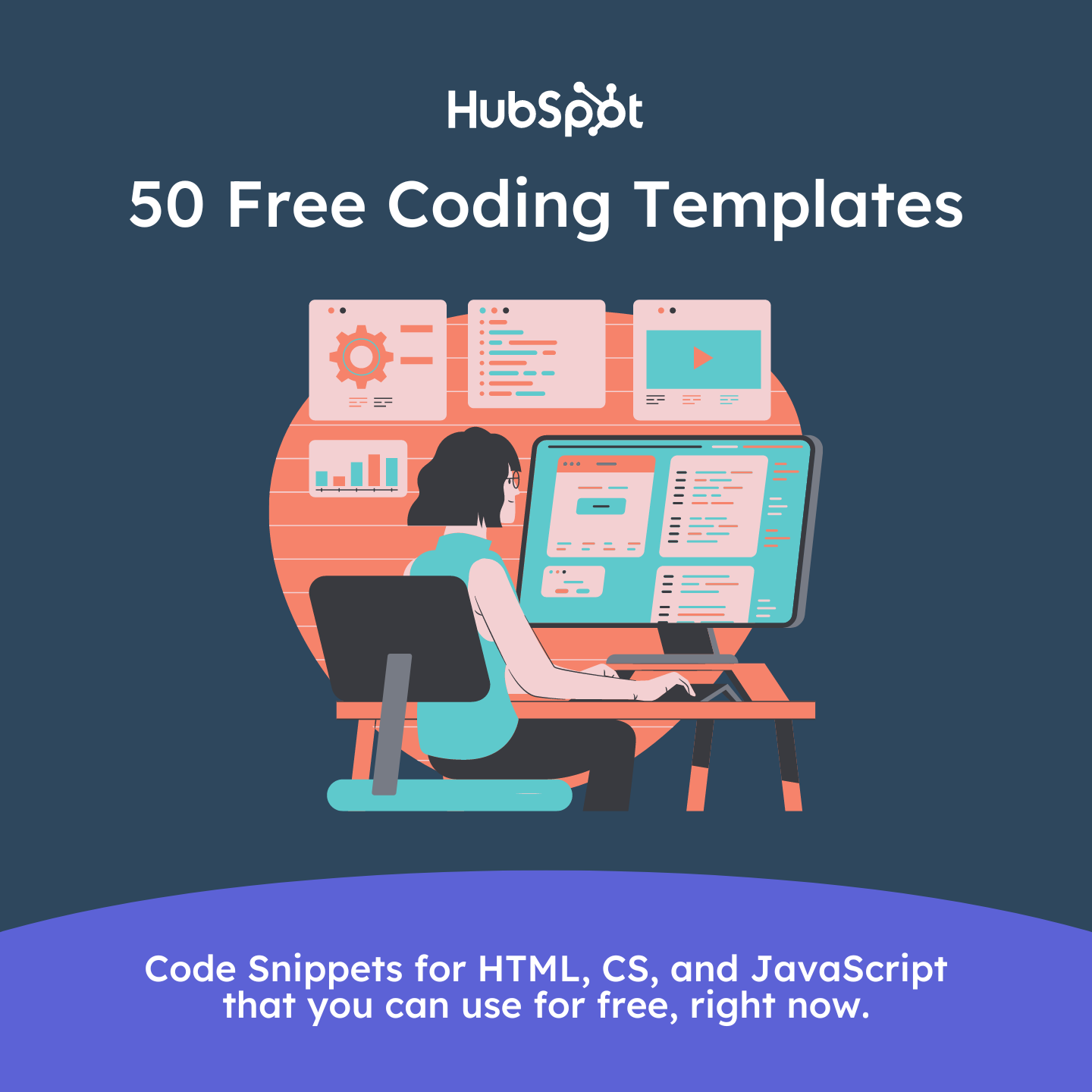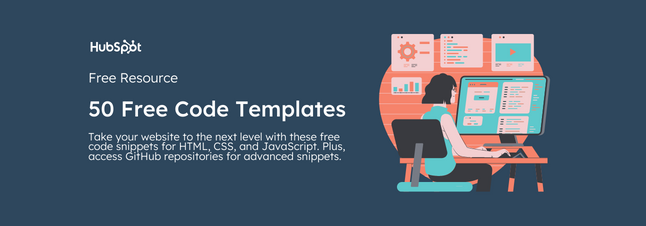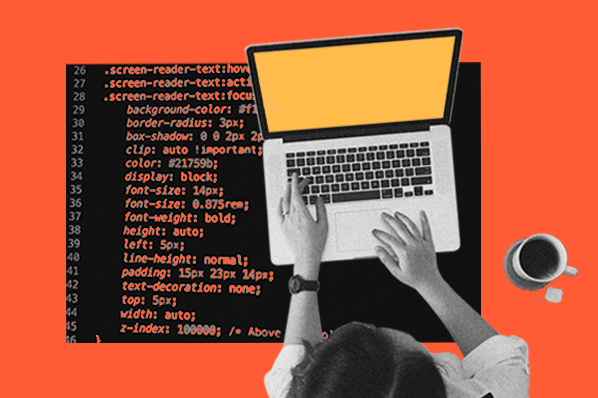We all know that coding is a helpful — if not essential — skill in today’s job market. However, if you try to learn without a guide, you’ll be left scratching your head.
HTML is a language with its own syntax and rules. Courses can help you learn everything you need to know in the right order. You’ll grow faster and be able to market your new skill with confidence.
However, finding the right course and certification can also be daunting. That’s why we compiled this list of the best HTML certifications, their prerequisites, and who may benefit most. Let’s dive in!
Table of Contents
- What are HTML certifications?
- Choosing the Right HTML Certification
- The Best Places to Get an HTML Certification
- The Best Free HTML Certifications
What are HTML Certifications?
HTML certifications are recognized certificates of completion. They show you have taken a course or passed a test that puts your HTML knowledge to use. Certifications act as a more tangible way of showing that you know your stuff.
There are plenty of low-or-no-cost options for learning how to code. So, what makes HTML certifications so special? Certifications that come with courses make learning easier. Instructors put all of the pieces together in the most logical order to ensure you learn quickly.
Further, you’ll make sure you learn everything correctly. You won’t develop bad habits that will be difficult to break.
For certifications following a test, you can demonstrably prove that you have mastered HTML concepts. Employers are more likely to believe your abilities if you can back them up with a certification. This can unlock opportunities in the job market and beyond.
Choosing the Right HTML Certification
Before we list the different certifications we suggest, let’s discuss how you can pick the right one for your needs. Let’s explore the factors to consider before you make a choice.
1. Identify your goals.
Why do you want to learn HTML? Are you looking to unlock a new skill so you can work more efficiently? Do you want to change careers and become a developer? Perhaps you already know how to code, but you want to level up and get a stamp of approval?
Write down two or three of your primary goals. Knowing your why will be the most helpful part of choosing the best certification for you.
2. Assess your current skill level.
You might be a total beginner, or maybe you know a few basics from your days running a Tumblr blog. You may have even taken a course in the past but noticed that you forgot many of those lessons. Take stock of any existing knowledge you might have. If courses have prerequisites, you’ll know right away if you qualify.
3. Research your industry standards.
Take a look around your industry. Are there any HTML certifications that seem to be the gold standard? This will help narrow down your choices as you look through the list below. Knowing what will impress your peers will guide you to the best choice.
4. Determine your price range.
Let’s talk money. Some courses cost a couple hundred dollars. Others cost a couple thousand. Some may require you to travel to a classroom — or perhaps you can learn how to code from bed. Knowing your maximum price range will help you narrow down your certification options to what you can afford. That will also help you avoid sticker shock.
Ready to embark on this exciting quest? Let’s begin!
The Best Places to Get an HTML Certification
1. Udacity Front End Developer Nanodegree
HTML is the foundational language of front-end web development. However, it often works in conjunction with CSS, which styles the content, and JavaScript, which makes some elements interactive. If you’re looking to go beyond just mastering HTML, this course from Udacity can help you learn the essential elements to build webpages.
Udacity offers “nanodegree” programs, or courses in tech that teach you essential skills. Plus, the platform partners with leading tech companies that require these skills. Further, you can take the classes asynchronously on whatever schedule suits you best.
This Front-End Web Developer program demonstrates how HTML provides the backbone of websites. Once you learn the helpful elements of this language, instructors incorporate CSS elements. You’ll then get hands-on experience constructing the layout of a site and making it responsive. JavaScript, a more complicated language, helps round out the course.
I love that this course offers engaging projects that are based on real-world scenarios. Further, learners get feedback on their work from experienced reviewers. You won’t just skate by after completing homework. Assignments really help you learn.
Offered by: Udacity
Cost: Approximately $249 a month, with an option to save 20% if paid annually.
What we like: Project-based learning with mentor support affords an ideal learning environment.
2. General Assembly’s HTML, CSS, & Web Design Circuit
When it comes to certifications, the institution backing you matters. But don’t worry. You’re in good hands with General Assembly (GA), a global educational institution with courses in coding, data science, and digital marketing.
If you’re looking to learn the basics, HTML, CSS, & Web Design Circuit by General Assembly is a part-time online course that can help. Instructions cover the fundamentals using HTML and CSS — the foundational languages of web design. The best part? You can finish the course in only 10 weeks!
The curriculum also emphasizes best practices for modern web design. Plus, you’ll learn from the best. Instructors in this course work for Salesforce Pardot, Kanopi Studios, and Thor Studio.
Offered by: General Assembly
Cost: Approximately $1,250 with a $250 deposit.
What we like: Many employers will pay for their employees to take this course. According to General Assembly, more than 45% of part-time students have their companies foot the bill.
3. Introduction to HTML5
Perhaps you want to learn in an academic environment without going back to a college campus. That’s where Coursera comes in. This learning platform partners with universities and educational institutions to build courses. You can even get degrees from Coursera.
But, let’s focus on HTML. This course, offered by the University of Michigan, focuses on HTML5 — the current version of the language that powers the internet. You can go beyond theory and textbook learning. This course has hands-on projects that allow learners to see how the coding language works in the real world.
Offered by: University of Michigan via Coursera
Cost: Individual course purchase or Coursera Plus subscription ($399 a year) with other purchase options.
What we like: This course provides both academic rigor and hands-on projects.

50 Free Coding Templates
Free code snippet templates for HTML, CSS, and JavaScript -- Plus access to GitHub.
- Navigation Menus & Breadcrumbs Templates
- Button Transition Templates
- CSS Effects Templates
- And more!
4. Pluralsight HTML Fundamentals
Let’s say you’re just starting your coding journey. You’ve never seen lines of code before or experimented on what these languages can do. Starting with multiple languages will be overwhelming. Instead, I recommend that you focus just on HTML. This course from Pluralsight can help you do just that.
When looking at the curriculum, I liked how the course was divided. Each lesson focuses on a specific skill — like working with text, creating a table, or creating a list. You’ll only learn a few HTML tags in each lesson, keeping everything bite-sized. As a result, you’re more likely to understand and retain the content.
Pluralsight’s course is also fast — totaling just over two hours. You can learn the basics, practice them, and then move quickly to another course with more complex information.
Offered by: Pluralsight
Cost: Subscription-based ($11 a month with a promo discount offered after a 10-day free trial).
What we like: Courses are taught by industry professionals.
5. LinkedIn Learning HTML Essential Training
If you’re already a LinkedIn power user, LinkedIn Learning allows you to gain new skills on a platform you already know and love. That includes a comprehensive course on the essentials of HTML.
Much like Pluralsight’s course, LinkedIn focuses on the building blocks of the language. However, LinkedIn’s version goes just beyond formatting texts and lists. You’ll also learn how to work with multimedia elements. That includes featuring images on your site, embedding video or audio, and making sure these elements are responsive.
I found that LinkedIn offered a helpful crash course — something more comprehensive than Pluralsight but never overwhelming. Plus, the content is updated regularly. If any major changes happen to the language, you won’t be behind the eight ball.
Offered by: LinkedIn
Cost: Subscription-based ($29.99 a month or $299.88 a year).
What we like: LinkedIn provides comprehensive coverage with regular updates. The subscription includes access to many other courses.
6. Ed2Go HTML and CSS Fundamentals
HTML and CSS often go hand-in-hand. JavaScript — a common third language — is much more complicated. Many find JavaScript intimidating if you’re just getting started. If that sounds like you, consider this course from Ed2Go.
Unlike other courses, the introduction covers a wide range of topics. That includes adding photos and text, then styling them so they dazzle. Modules are broken up over six weeks, making sure you remain committed and don’t absorb more than you can handle at once.
Are you the type of person who can self-motivate, or do you work better with a teacher to guide you? Ed2Go offers options for both.
You can take a self-paced version, where you play videos whenever you’d like. Alternatively, you can opt for an instructor-led version. Here, you log into class at a set time and a set starting date. I love how there are options for both types of learners.
Offered by: Ed2Go
Cost: Self-paced $185 or Instructor-led $170; you can also pay through Affirm.
What we like: There are structured lessons with assignments with diverse course avenues and payment options offered in partnership with your preferred school.
7. W3Schools HTML Certification
Even as someone who has mastered HTML, I still have questions. I may not remember a certain bit of syntax, or perhaps I want to copy and paste a line of code instead of writing it from scratch. When I’m in a bind, I go to W3Schools, a renowned resource for web developers.
So, W3Schools means a lot to both developers and learners. That’s why the organization’s HTML Certification has clout. If you already know your stuff, this exam will validate your HTML skills. Potential employers can then see you have learned and internalized the essentials of this language.
Offered by: W3Schools
Cost: $95 with a 14-day, money-back guarantee.
What we like: Established and respected in the industry, W3Schools offers a straightforward and budget-friendly certification option.
8. HTML & CSS - Certification Course for Beginners
With over 130,000 courses spanning a range of topics, Udemy connects experts to learners to spread knowledge. Courses on Udemy often come with lifetime access. This means you can buy the course once, start learning, and revisit any lesson if you need a refresher.
That’s why we love this reasonably priced introductory course from Udemy. You’ll learn the HTML tags you need to code content from your website. Then, you’ll dive into the structure of CSS and how it interacts with the HTML you’ve written.
Each course usually includes video lectures, assignments, and quizzes. You can both finish lessons and make sure you actually retain the information.
Offered by: Various instructors on Udemy
Cost: Variable, typically ranging from $10 to $200 per course or $16.58 per month, depending on which plan you choose.
What we like: Udemy often has sales, making courses very affordable with multiple courses offered.
9. Simplilearn’s Introduction to HTML Course
Simplilearn’s introduction to HTML is another course that focuses on only one coding language. This five-hour, self-paced program focuses on the essentials of HTML. That includes how to build the structure of your site with navigation, classes, and IDs.
I like how the Simplilearn course provides enough information for learners to build sites from scratch. In order to actually bring their work to life, they will need additional coding languages.
However, learning concepts like navigation provide the foundation for developing sites on whole. This is great if you want to do more than just edit existing code.
Offered by: Simplilearn
Cost: Variable based on region and offers.
What we like: Instructor-led training options are available, along with many free courses.
10. Codecademy’s Learn HTML
Codecademy is an online interactive platform offering coding tutorials in a wide range of languages. The Learn HTML course offers a great starting point for beginners. Each lesson is interspersed with a quiz to check how much you’ve learned. Further, each model ends with a project for you to put your knowledge into action.
Codecademy also includes an interactive platform where you can write code for your projects. AI will review your input and identify areas where you could use more help. It’s like having a dedicated tutor to check your work.
Offered by: Codecademy
Cost: Basic courses are free; the pro subscription is $19.99 a month.
What we like: Codecademy is an interactive platform with instant feedback.
11. Treehouse’s Introduction to HTML & CSS Course
Whenever I go to the movies, I’m always shocked by the long runtimes. Almost every film clocks in at over 2 hours — often over 2-and-a-half. In just 183 minutes, around the length of a movie, you can dive into the world of HTML. That’s all possible on the technology learning platform Treehouse.
This HTML course from Treehouse provides a user-friendly introduction to HTML. All instructional videos are under 10 minutes, making sure content doesn’t drag on and get forgotten. Each section has a small project for you to complete so you can put your knowledge to the test.
Offered by: Treehouse
Cost: Subscription-based ($25 a month or $49 a month).
What we like: Treehouse provides a friendly interface with gamified learning, along with many specializations to choose from.

50 Free Coding Templates
Free code snippet templates for HTML, CSS, and JavaScript -- Plus access to GitHub.
- Navigation Menus & Breadcrumbs Templates
- Button Transition Templates
- CSS Effects Templates
- And more!
The Best Free HTML Certifications
12. FreeCodeCamp’s HTML for Beginners
Not everyone operates well in an instructor-led environment. In some cases, you may prefer to learn by doing. FreeCodeCamp, an open-source community, focuses on helping people learn by building projects. It provides a self-paced boot camp with interactive lessons and projects in web development and other areas.
To get a taste of FreeCodeCamp’s model, I signed up and looked at their curriculum. By completing a certain number of modules and testing your skills, you can earn certifications. The first part of the curriculum focuses on HTML. To learn, you’re asked to build a photo app of cats.
You’ll then have the process broken into smaller steps so you can code along. You have access to a terminal-like interface. Here, you can write code directly, have the system check what you wrote, and check your results. I love how digestible each step is. The process becomes both manageable and fun!
Offered by: FreeCodeCamp
Cost: Free
What we like: FreeCodeCamp is an interactive platform with a vibrant community, offering practical hands-on exercises.
13. MDN Web Docs: Learning HTML
MDN Web Docs, managed by Mozilla, is a primary resource for detailed documentation and learning resources for web developers. Mozilla’s Learning HTML guide is one of those helpful resources. However, this resource is not for the faint of heart. You need to be incredibly self-motivated to make it through.
Let me explain. Instead of having modules with videos and lessons, the Learning HTML guide is one document with a series of links. You’ll click from the main doc to sub docs that have information about how to code. It’s on you to read the text and test the code in a separate browser window.
I wouldn’t recommend this method for people who are completely new to coding. However, Mozilla’s guide is a helpful resource for those looking to build upon nascent, existing skills. There’s much to be learned here. You just have to get past the formatting.
Offered by: Mozilla
Cost: Free course materials, but no official certification.
What we like: MDN Web Docs is a trusted source of web documentation with expertly curated content.
14. SoloLearn
SoloLearn is an initiative by a dedicated community of educators and developers. That’s why its Introduction to HTML course offers a solid introduction to the building blocks of the web. This course starts with the basics, including how to write text and feature images on a page. From there, you learn about how HTML can be used to structure a page and build a website.
Like many other platforms, SoloLearn offers quizzes and projects along the way. Frequent checkpoints make sure that you don’t forget what you learn once a video ends.
Offered by: SoloLearn
Cost: Free resources
What we like: SoloLearn provides cutting-edge, straightforward info.
15. HTML Dog Tutorials
HTML Dog is another helpful resource for web developers. If you can’t remember a specific tag, need a line of code, or just have a question, HTML Dog is a helpful spot to learn the answer. That’s why I wasn’t surprised to hear about the platform’s comprehensive tutorials.
HTML Dog’s tutorials are meticulously organized, allowing learners to select content based on their proficiency level. If you just started to code today, you can find something for your level. If you’re looking to levelup already existing skills, you can do that too.
The clear and concise nature of the tutorials makes them easy to follow. However, this content is largely text-based. If you’re a visual learner, you’ll want to try courses on a different site that include video.
Offered by: HTML Dog
Cost: Free tutorials, no certification
What we like: Their clear, concise, and categorized tutorials for different learning levels.
Start learning HTML online.
If you want to become a web developer, HTML is a foundational coding language that you must know. Certifications and courses can help you learn the nuances. Plus, you’ll get a stamp of approval, showing that you know your stuff.
Whether you’re a beginner or just looking to prove your abilities, finding the right certification can help you achieve your goals. So, make a plan, sign up, and get started.
![Download Now: 50 Code Templates [Free Snippets]](https://no-cache.hubspot.com/cta/default/53/cace6948-d859-40c5-ad73-a401be3aa84e.png)




![HTML Projects for Beginners: How to Create a Personal Portfolio Page [Step-by-Step]](https://blog.hubspot.com/hubfs/personal_portfolio.png)